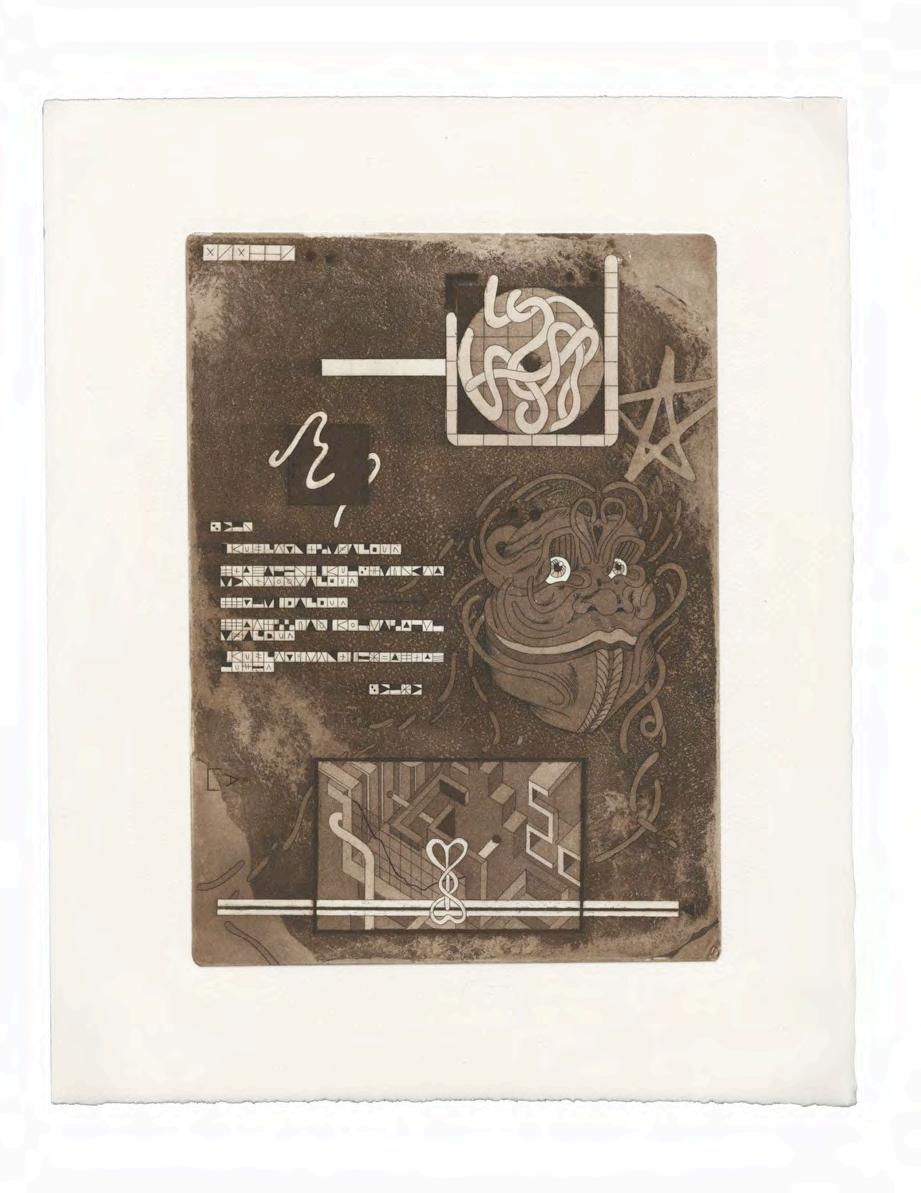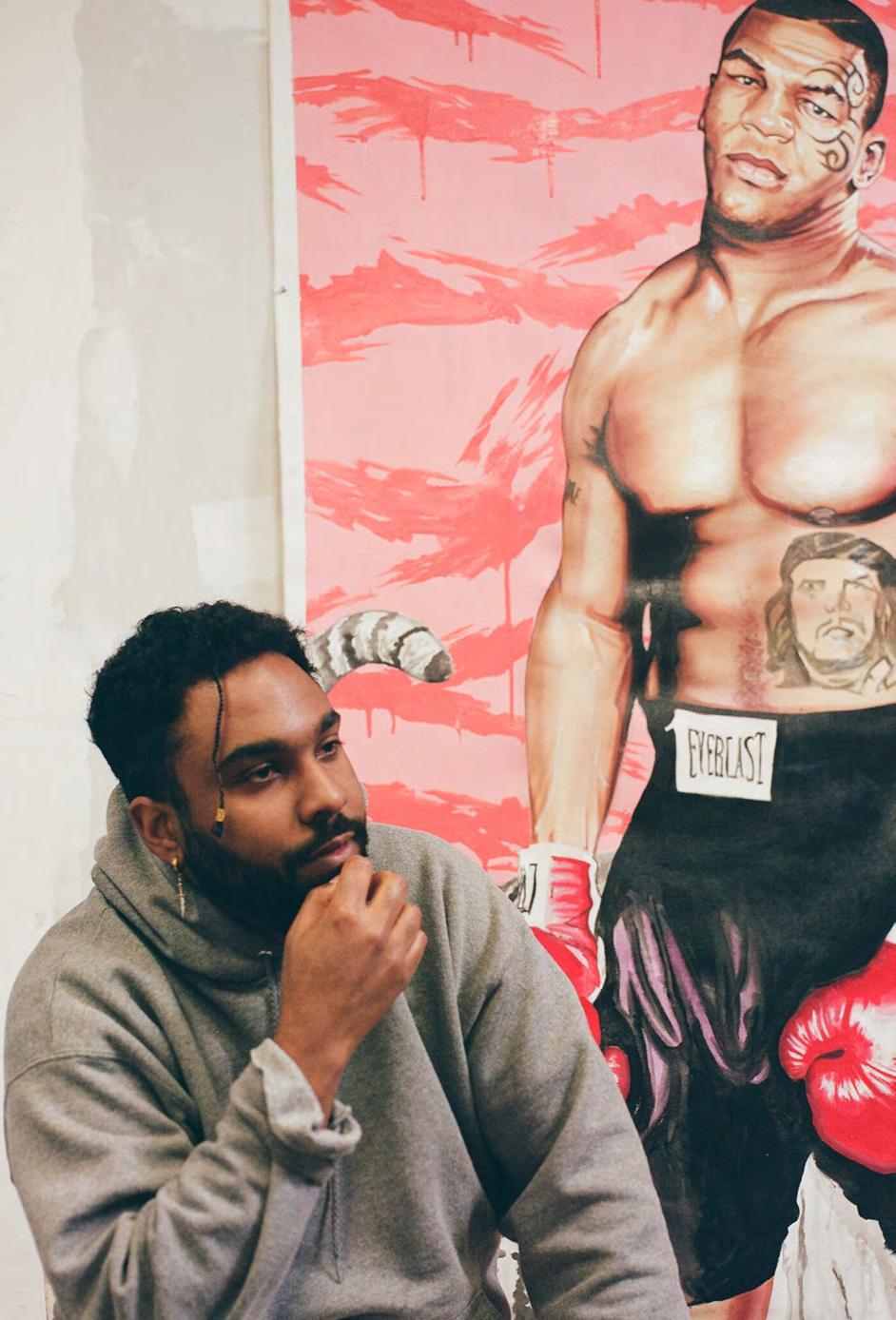
6 minute read
Erika Shiba


Advertisement

What is it that you create?
My practice consists of printmaking and drawing - I create a psychological universe, which I like to call a “mentalscape,” through my etchings and graphite drawings. The work I make exists as documents of discovery in this space. I also enjoy suggesting logic, then contradicting it. I use geometric forms to signify balance and stability and then pair them with structures that defy the laws of architecture. These are often convoluted and operate as metaphors for cognition.
How did you find printmaking?
I took an “Intro to Printmaking” class my second year of college - I signed up for it with little to no knowledge or expectations to simply fulfill my academic requirements. As the course went on I slowly started to fall in love with the intricate process of the different printmaking techniques as well as their versatility. The love and energy I felt in the print shop was also something that drew me closer to it every time I went in to print. The community and support of printmakers I have met is truly special and I find them to be one of my biggest inspirations whilst making work. Your work uses black and white to play with light and shadows, what do you enjoy about the absence of color?
Colors have many connotations attached to them so I think working in a monochromatic palette allows me to focus purely on form and shape. I also think, in terms of my drawings, that graphite gives a cold, detached and sterile quality to the overall image. This lets me think of the mentalscape universe as a space that has never been touched by outsiders; this symbolizes the inaccessibility of one’s psyche to others.
How does printmaking as a medium give you the ability or freedom to do that other mediums don’t, and inversely, where does it limit you?
As a drawer, one of the first things that enticed me to printmaking was the ability to create multiples of an image. Unlike a large painting or a drawing that could be owned by only one select person, printmaking is more democratic in that the same print can be dispersed and enjoyed by a larger group of people. Another quality I enjoy about printmaking is the physical and time-consuming nature of its process. It involves a lot of steps to create a print which requires you to move around the shop a lot and be very physically involved in its process. Oftentimes when I am working on a plate, I’m suspended
Mentalscape V.4, 6”x12”, graphite on BFK paper, 2020

in a mental vacuum where I can block out the outside world. I also love the problem-solving aspect involved in printmaking — when something goes wrong technically, it requires me to do some mental acrobatics in order to figure out the issue. As an artist, it is also freeing to have the ability to be experimental with a traditional process.
You have recurring shapes and objects. What is it about symbols that you enjoy?
When I can’t speak my thoughts, I draw. For this reason, I view the symbols and shapes that I create to be extensions of my psyche. Each symbol I create, which I like to call “thoughtpoints,” represents journal entries, inner dialogues, or memories. Sometimes I construct a form with a certain emotion or thought in mind, which can be personal, political, or cultural. Other times I intuitively make a form and assign meaning to it after the fact. The meaning and existence of these thoughtpoints are covert and vague to conceal their origins from viewers. Codifying my thoughts allows me to externalize my psyche without oversharing or revealing too much, which I find to be a vulnerable and intimate act that I am not ready to do yet in my work.


Mentalscape Study, 6”x8”, graphite on BFK paper, 2021

Document V, 12”x16”, copper etching on BFK paper, 2020

How are you able to go back and forth from rigid architectural structures to free-flowing organic pieces and then seamlessly combine the two?
I enjoy placing opposites next to one another to create tension. The free-flowing forms that are more animated balance out the rigid impossible structures I build. How I make them interact is a fairly intuitive process; the way the architecture that starts to take shape informs the more organic shapes that I place against them and vice versa. I am drawn to the magic of the impossible. As the architect of a fantastical universe, I enjoy leaving some references that, at first glance, seem to be part of our real-world yet become increasingly peculiar and illogical the longer a viewer sits with it.
Your works often feel architectural while also feeling tethered to human or natural form, where do these two converge in your mind and work?
Your prints often remind me of mazes, puzzles, and especially the Penrose triangle, is there something about the impossible and improbable that you enjoy playing with?
The architectural structures are built sort of like how a stream of consciousness or a train of thought

might manifest in one’s mind in that one part of it informs the next. I also view it similar to the act of writing - the structures flow onto the paper like a sentence. By trusting my intuition and using it to establish the structures within the mentalscapes, the imagery I build becomes a projection of my mind. With that in mind, the creatures I create are inhabitants of that psychological universe and act as my proxies to navigate this space. These creatures, aside from being my surrogate, have the ability to explore the mentalscapes by deciphering the codified languages. I like to think that sometimes these figures also leave codes for a future version of myself. What are your hopes for your work, where it goes, who sees it, or is it a catharsis for yourself more than anything?
Right now my work is a place for escape as well as self-reflection. When making work, I am in a hyper focused state which is meditative and cathartic. Drawing and ideating different sketches allow me to investigate my journal entries, and by extension, my psyche. Reflecting and confronting my past memories and behaviors has helped me immensely in my pursuit of having a better sense of self. Also, as I continue to grow my body of work I hope to use my voice as an artist to talk deeper about my home of Hong Kong and its changing political landscape.











